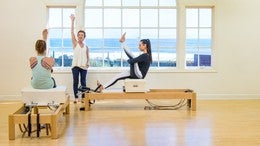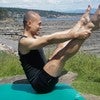Description
About This Video
Transcript
Read Full Transcript
Hello everyone, I'm Debora Kolwey. Really, really happy to be back at Pilates Anytime from Boulder, Colorado. Today I'm here with Shelby and Anna. We're going to be doing a small tutorial that came up for me as an inspiration from being someone who teaches a teacher training program and has to test out people. People would always come to me and say, for my test, do I have to do everything?
Do I have to do the whole short box? Do I have to do every variation? And I would usually say something like, what I'd like you to do is the fullest expression of the exercise that you're able to do. And so, what I began to realize was that people thought that all the different variations that one does are actually different exercises, as opposed to a progression of skills leading you into larger and larger, more full-bodied movement based on the fundamental movements that are inherent in many of the series. The short box series, the stomach massage series.
So today, we don't have time to actually explore the entire short box, so we're gonna look at a small piece. And one of, I think, the more fun parts, which is to show how the naturalness of all the spinal movements take you into the next one. And if you look at the foundational bits and start to consider how each one is a progression into the next stage, the whole idea and ability to progress into what we might call more advanced versions, it's just not that hard. You can do it. So we're gonna start with the typical round back on the short box.
You wanna make sure that our setup is very, very good. As best you can, your setup is that the strap is on your ankles and you can get a nice deep flexion at your ankle. You've got not much more than a hand of space behind your pelvis and the back of the box. And you wanna be able to strongly press your legs down and apart to get a balance of musculature around the hips and strong legs. For the first one, we're gonna wrap our arms around the rib cage, and I know that this shape tends to encourage the rounding forward of the shoulders and the hunching of the back, which is actually not what we wanna do.
If you think about that, we can work with it. So using a strong position of your arms, actually pressing your hands into your arms, and going to scoop your belly with the strength of your arms. Use that as not only a hugging in, but you can think of pulling the elbows apart and down slightly and that sets some strength around into the back of the shoulder girdle, which will help you avoid the hunching feeling. So you're simultaneously picking yourself up, and then you're going to bend over so that the weight of your body is right on the back of your pelvis. So breathing in, start to roll back.
Keep the flex of the heels and the ankles very strong and literally move the pelvis. And then as you exhale, you're gonna dive the head forward and come back up. So we start small. We always think of this as a belly exercise, which of course it is, but really what you're also doing is starting to rotate the pelvis, go into a pelvic tilt, opening the hips, exhaling as you come back forward. What's tricky is that when we roll back, we wanna watch out that we don't drop the pelvis and compress the lower back.
So as you roll back, the pelvis is rotating, yes, your sit bones are tilting under, but they're not driving you down. They're actually picking you up. And if you can keep the flexion of your ankle working with that, then the heel and the sit bone exhaling coming back together is gonna help you. Exhale as you come forward. You're building a base of support based all the way down from the deep flexion of the ankle, the strength of the leg, up into the hips.
And then if I wanted to partner Anna I could get in here with her and really be another set of arms. I'm gonna wrap my arms around her lower belly, pick her up, and then breathe in. As I pull her back I'm buying her more space in the front of her hips so that she can get more out of her ankle flexion and more out of the power of the back of the leg, pressing down, to give her space in her hips and her spine to be able to successfully exhale and roll forward. As you know, eventually this goes into a deeper and deeper movement. That's your foundation.
Now we go into the flat back and when we're new, we take the hands behind the head. So this strength that you built from wrapping your arms and lifting up, connecting the arms into the shoulder girdle and to the rib cage helps get carried into this next position. Pressing your head and your palms into one another, can you still feel that tone coming around the whole back of the arm into the back of the shoulder girdle? Now you're sitting more upright. The same power from the bottom part of you has to be at work.
Breathing in, up you go, take yourself back, tilt back, keep the gaze down so that you're not encouraging your head to fall back, exhale as you come back up. The power of the strength of the arms into the shoulder girdle is holding you up, and the power of the flexion of your ankle that lifts the back of your pelvis up. So, ankle, sit bone, lift off my hand, exhaling as you come forward. And if you choose to go farther, what opens up more is the hip. So try going a little bit more, deep in the movement.
But instead of falling back, flex your ankle more, and extend your hip more, press your legs down into the box and apart, to strengthen the hip complex so that you can come up. So that's great, right? Even that kind of basic movement can be very challenging. Then we add the pole, we straighten the arms and we add the pole. Now suddenly you're reaching your arms up overhead and they're far away, but your hand holding that pole still has to have the same strength of connectivity all the way down from the palm into the back of the arm.
And if your chest is tight, and your shoulders are tight, and it's hard to get the bar up, what do we tend to do? We actually pull our back down thinking that we're lifting up. So you can play with bringing the hands a little bit forward, reaching the whole body forward, so that you lean forward a little bit okay, Anna, so that you can show how now the weight is really gonna be over the back of the leg again and you can go back to employing this same strength of the flex, which lifts the pelvis. You can use your back more strongly. Then we go back with the arms straight, holding the pole.
The pole is something to lift up in to, go ahead, but you have to keep reaching up into it, trying to keep the flex of the ankle to tilt the pelvis, exhale as you come right back up. Very, very good. So again and again, the further back you go, the more you have to maintain and not only maintain but increase the foundation that you started to work on, the flex of the ankle, the lift of the back of the hip. So go back one more time. No falling.
Press the back of the legs down and apart and lift your back up. So now put the stick down for a sec. We'll go into a small side bend. If you were doing a class and you were at a certain level, you wouldn't necessarily be showing or doing all these little pieces, right? You might be only holding the pole.
But we're just gonna kinda keep revisiting because I think it feels good. Now you have that same idea, we're taking it into a slightly different spinal movement, lateral flexion. Now the hands pressing into the head, connecting the arms into the shoulder girdle to lift the ribs to house the spine into a sideward motion now. Breathe in as you go over to the right. Exhale as you come back.
And notice if you can feel literally your shoulder girdle moving your rib cage side to side. Then the question always comes up, should I let my hip come up? So the point isn't whether you should or shouldn't let your hip come up, but at this stage we're still working on the foundation of the stability of the pelvis so that you know that you're actually just moving this part. What happens if you start to go over and you fall? You can see it's less of a spinal bend.
You're going farther, but it's less of a spinal bend. Now when we go to grab the pole and take our arms up, inherent in the fact that we've now taken our arms up overhead is more length, more space, the need for more strength all the way around. So it makes sense to go farther because suddenly you're a bigger person. You're a smaller person here with less need to reach out in space. Now you're a bigger person with more expression.
It's logical to go farther, you know? As you go over now, you might wanna be able to reach further. You're still trying to get more spinal bend, so here's that underneath hip coming into play. Exhale as you come back. Can you also feel when you go to the side, if you can stay in touch with the feeling of the two hands, the two arms, the two shoulder blades?
If you go to a certain side, and you actually don't feel that shoulder blade anymore, then you start to get suspicious, you know something's up. Can you feel one side or the other? When you go to one side, maybe you really feel that shoulder blade tucking its way in and helping to lift you up as the other one stretches and reaches and opens. Beautiful. And then maybe to the other side you don't feel it quite as well, so then you think, hmmm, maybe I need to rotate slightly forward so that I'm using those muscles, you see?
Okay, one more time. And then, just for the feel good of it, everybody go to the right, put your right down on the box. This push is very nice because you can feel how again and again the connection of the hand to the arm to the shoulder girdle, it's gonna lift you up now, it's like an assist. It would be like as if I came over and picked you up. If you're pushing yourself up, it gives you more room, then you have access 'cause you're not collapsing down, so then you can think, maybe I'd better refocus on my flexed ankles and my strong foundation.
One more time. Over you go, to the left. Go ahead and put the left hand down. Don't lift your hip yet. Get as much bend, use the assist of the arm that's pushing you to get more open and then lengthen and then feel the underneath hip side, there you go, reach out, get the stick.
And excellent, come back up, and if your arms are tired, maybe put them down for just a sec. Actually, go ahead and put 'em down anyway 'cause we're gonna twist now with the hands behind the head. Just that very beginning, you know, when we said, okay, I wanna get my ankles flexed, I'm gonna press my legs down and apart to get the balance of the outer hip, the inner hip, the back of the leg. Because the front of the legs, they like to take over so much we lose sight of these other parts. It's like sewing something or, I don't know, embroidery.
You just keep weaving in the next little piece. You don't throw the other one away. The whole picture is the sum of all the little parts that came before. Now we're gonna twist. Twisting is, first you're gonna lift and rotate.
And for the beginning of this, we're gonna keep it small. We wanna make sure that you don't hurt yourself, for one thing, or that you feel a true twist, so you're gonna roll that pelvis back, flex the ankles, as you start to twist tilt the pelvis by flexing the ankles, bring everything with you, and then exhale, come back up. We'll look at your left side now. Inhale, keep strong, roll the pelvis back, but flex the ankles so the rolling back is not a drop. And you feel you have to lengthen this left side around and use it.
You're going toward that side. Exhale, beautiful, come back up. The side to which you go actually has to be almost a little smarter, a little more clever, to hold you up so that you can eventually go bigger, but not collapse into yourself. The question here, should I let my hip come up? Well, not yet.
Because you really wanna feel your foundation. Okay, go ahead and take the pole. Necessarily so, you're going from that little bit of deeper flexor support, working your way through, now as you go up and have the pole, you are naturally needing more back strength. Now your twist can get bigger because you're gonna go farther out in space. So the farther out you go, the more load, the more it behooves you to bring your feet and legs with you, and then exhale, come back up.
As you twist to the left, make sure that your wrists are straight and that you're maintaining the connection, and that you're not just moving your hand. So you lift and you rotate and then you start to go out, you have that memory of tilting the pelvis for the power of it, beautiful, exhale, come back up. Now it could get interesting because we'll say, should I let my hip come up? What it is it just depends how far do you wanna go? If that's as far as your twist, if your twist is only going out to the corner of the frame of the box, then that's it.
But if you wanna keep twisting, you have to pick the rest of your body up with you and bring it along. So as you continue to twist now, bring your legs together, we call it twist off hip, we give it another name. But it's just actually a larger version of the same thing. You're gonna continue to rotate and feel how the muscles pick you up and pull you over. That's it, now you can put your right hand on the frame of the box if you like for a moment.
Just like you put your hand on the white box, use that as an assist to pick you up, to pick some of your weight up so that you feel okay about completely rotating onto your side. Isn't that fun? Mm hmm. And then the back, the underneath leg, excuse me, has to push that top leg up, and then if you can, reach your right arm to grab that pole. Awesome, and then come right back up.
That was really great. Let's do the other side. Maybe not so slowly (laughter). I'm tryin' to talk as fast as I can. (laughter) So you feel the naturalness of it.
When I first learned this exercise I used to just kinda throw my hip up and throw myself out in space, and I thought that was really fun and cool. It was like a challenge, I'm gonna throw myself in space and see if I can hold myself up. There's nothing wrong with that. But it was later that I was like, oh, this is actually a progression and it feels so great. You see your arms lifting up.
They become the top of the spiral, you can see this whole thing, if it keeps going, it naturally picks everything up all the way into the pelvis. If your thighs are tight, it's hard. Go ahead and put your hand down if you want to, just enough to get yourself, you can put it on the frame or the box. And see if you can flex your ankles and push that bottom leg up. It feels very, very good once you get there.
And now, take a nice deep breath, grab that pole, and come back. Yeah. Okay, so go ahead and put the pole down. From here we could go into spear the whale, we could go into 'round the world, et cetera. But I think for today that's enough.
Just sorta showing how important those foundational bits are and how you can just carry them through. You know, you started out here, look where you got. (laughter) Okay, great.
Comments
You need to be a subscriber to post a comment.
Please Log In or Create an Account to start your free trial.
























